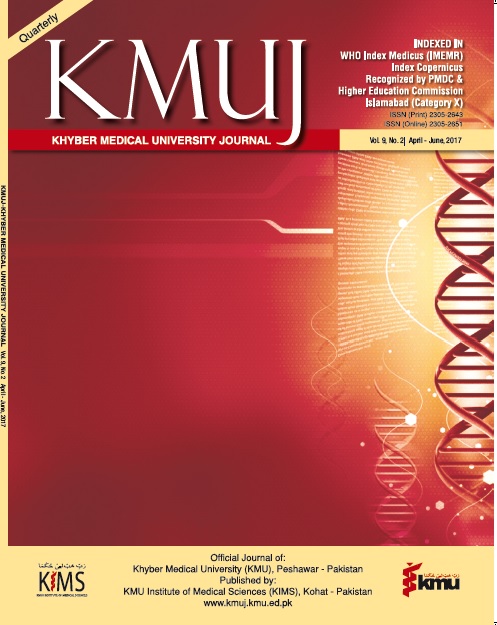PRESCRIBING PATTERN OF DRUGS FOR DIABETIC PATIENTS IN A TERTIARY CARE PRIVATE SECTOR HOSPITAL, PESHAWAR, PAKISTAN
Main Article Content
Abstract
ABSTRACT
OBJECTIVE: To determine the prescription pattern of drugs in hospitalized diabetic patients attending a tertiary care private sector hospital, Peshawar, Pakistan.
METHODS: A retrospective study was conducted for 2 months (January, 2015 to February, 2015) in the department of endocrinology of a tertiary care private sector hospital, Peshawar, Pakistan. A total of 254 prescriptions were analyzed during the two months period. Prescriptions of all diabetic patients were included regardless of gender, economic status, religion and ethnicity.
RESULTS: The study revealed that 254 prescriptions includes 59% (n=150) female and 41% (n=104) male patients, majority age group was 60-69 years. Most common concurrent disease with diabetes was hypertension (31.63%). The maximum time spent by diabetic patients in hospitals was 3-days (27.15%). The most prescribed drugs to the diabetic male and female were cardiovascular drugs (26.11%) and (21.80%) respectively followed by antibiotic (17.04%) and (16.02%) respectively. Most common prescribed dosage form to the diabetic female was tablet (46.19%). While in male the highly prescribed dosage form was injection (45.84%). The most frequently prescribed anti-diabetic drug was insulin (46.46%). Most frequently prescribed anti-diabetic two drug combination was sitagliptin+metformin (40%). Among highly prescribed anti-diabetic three drugs and four drug combinations were insulin+sitagliptin+metformin (39.13%) and insulin+vildagliptin+metformin+pioglitazone (42.85%) respectively. The most frequently antibiotic prescribed for the management of diabetic foot was ceftriaxone (14.45%).
CONCLUSION: Insulin was highly prescribed drug followed by metformin and glimepiride. Hypertension followed by chronic renal failue and coronary artery disease were highly prevailed comorbidities. The most commonly drugs prescribed apart from antidiabetic were cardiovascular followed by antibiotics.
KEY WORDS: Prescriptions (MeSH), Prescribing pattern (Non-MeSH), Diabetes Mellitus (MeSH), Injectables (Non-MeSH), Comorbidity (MeSH), Morbidity (MeSH), Dosage Forms (MeSH)
Article Details
Work published in KMUJ is licensed under a
Creative Commons Attribution 4.0 License
Authors are permitted and encouraged to post their work online (e.g., in institutional repositories or on their website) prior to and during the submission process, as it can lead to productive exchanges, as well as earlier and greater citation of published work.
(e.g., in institutional repositories or on their website) prior to and during the submission process, as it can lead to productive exchanges, as well as earlier and greater citation of published work.
